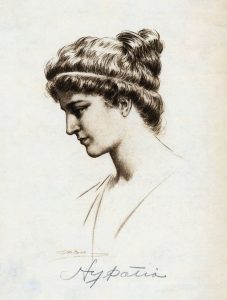
Picture by: Bettmann/CORBIS
While we cannot be sure who the first female mathematician was, Hypatia can certainly be named as one of the earliest and most inspiring.
She was born in 355 BC and was the daughter of Theon, the last known member of the famed library of Alexandria. She was, in her time, the world’s leading mathematician and astronomer. She’s the only woman for whom such a claim can be made, according to Encyclopedia Brittanica.
Mathematician and Astronomer
According to the Smithsonian, “she collaborated with her father on commentaries of classical mathematical works, translating them and incorporating explanatory notes, as well as creating commentaries of her own and teaching a succession of students from her home.”
As a popular teacher and lecturer on philosophical topics of a less-specialist nature, she attracted many loyal students and large audiences. Her philosophy was Neoplatonist and was therefore seen as “pagan.” The timing could not have been worse, given the bitter religious conflict between Christians (both orthodox and “heretical”), Jews, and pagans.
Hypatia as Philosopher and Symbol
Given that Hypatia was also a philosopher, she gave lectures about Plato, Aristotle, and her belief system in which everything emanates from the One. She was immensely popular, but that was her downfall, however. She became a convenient scapegoat in a political battle between her friend Orestes, the governor of Alexandria, and the city’s archbishop, Cyril, and was killed by a mob of Christian zealots.
Hypatia has become a symbol for feminists, a martyr to pagans and atheists and a character in fiction. She remains an inspiration even in modern times, where the number of women in mathematics still lags behind their male counterparts despite being equally capable and interested.
The Modern Female Mathematician
According to The Atlantic, “just 15 percent of tenure-track positions are held by women, one of the lowest percentages among the sciences, along with computer science (18 percent), and engineering (14 percent).” While the reasons for this are currently under scrutiny, there is evidence of the “brilliance effect”, sexism, and early cultural bias at play.
Fortunately, one solution is to continue to highlight successful female mathematicians, from ancient to modern times, to help shift the perception of women’s role in this field. As Professor Chad Topaz says, “If half the world’s population is not participating in math, you’re missing out on half of the really good people.”
Here at The Open Bench Project, we hope to do our part to help shift this statistic. Thanks for joining us!
And then some,
Your Friends @ OBP


Recent Comments